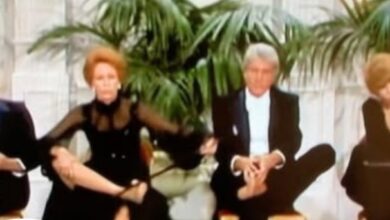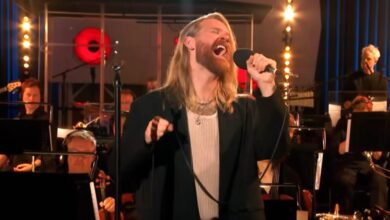The Sound of Silence Reimagined: A Powerful Modern Revival
From its very first breath, Dan Vasc’s rendition of “The Sound of Silence” establishes an atmosphere of patience and purpose. Instead of launching straight into the commanding force fans might expect from his metal background, he begins in near stillness. The opening moments float delicately, every note placed with intention. By resisting the urge to rush into power, Vasc allows the silence itself to become a co-star in the narrative. This tension builds anticipation, preparing the listener for the inevitable eruption. Each pause carries weight, shaping a sense of foreboding calm that mirrors the lyrical theme of communication and isolation.
The song’s legacy gives that stillness even deeper meaning. Originally crafted by Simon & Garfunkel in the mid-1960s, it started as a gentle reflection on loneliness before evolving into one of the most enduring ballads of modern music. Decades later, Disturbed reimagined it with dark orchestration and emotional grandeur, redefining how modern audiences perceived its melancholy. With this long history behind it, any new interpretation faces towering expectations. Dan Vasc doesn’t simply replicate those who came before; he reinvents the structure by fusing classic sensitivity with the weight and drama of cinematic metal, revitalizing a song that has already lived many lives.
The beauty of Vasc’s version lies in its control. He guides the song’s intensity like a seasoned storyteller, shifting seamlessly from fragile whispers to commanding thunder. In the early phrases, his tone feels personal, intimate—as though the listener is being confided in directly. Gradually, the arrangement swells beneath him, introducing strings that shimmer, drums that pulse like a heartbeat, and harmonies that gather momentum. By the time the song hits its towering peak, the progression feels natural, almost cinematic, as though the audience has witnessed an emotional storm gather and finally break free in full force.
Vasc’s vocal performance is a showcase of skill, control, and emotion. His lower register exudes warmth and quiet conviction, grounding the melody in sincerity, while his upper notes soar with the kind of power that vibrates through the listener’s chest. Instead of merely increasing volume, he adds texture and resonance, giving the climax depth rather than sheer loudness. Each transition feels deliberate, the movement from soft to strong handled with surgical precision. The result is a performance that feels alive and human—equal parts vulnerability and triumph.
The instrumental arrangement builds around that vocal arc like a film score. It begins spare, the piano marking time in delicate strokes, and then slowly blossoms into an orchestra of emotion. Strings weave a thread of melancholy through every measure, while the percussion waits until the right moment to strike, amplifying each revelation. The layering is meticulous; nothing enters without reason. As the sound widens, the listener is transported, enveloped in a soundscape that feels both epic and deeply personal. Every swell and drop serves the emotional architecture of the story being told.
Visually, the accompanying video captures that same sense of intent and restraint. Rather than relying on flashy transitions or heavy effects, it stays close to the artist, focusing on expression and atmosphere. The simplicity of its presentation underscores the music’s honesty. Vasc’s body language, his subtle movements, even the stillness between phrases—all of it conveys conviction without exaggeration. It’s a reminder that authenticity doesn’t require spectacle. When the artistry is this genuine, the performance itself becomes the visual focal point.
Longtime admirers of “The Sound of Silence” find themselves rediscovering its relevance through this lens. The song’s reflections on disconnection, noise, and misunderstood voices resonate more than ever in an age dominated by digital chatter. Vasc channels that modern alienation into a performance that feels both contemporary and timeless. His voice becomes the bridge between eras—the folk poet’s lament reborn as a modern anthem of awakening. That duality keeps listeners spellbound, finding new meaning in words they’ve heard for decades.
When the arrangement finally erupts, the transformation feels cathartic. The quiet introspection of the opening gives way to something colossal—an eruption of sound that seems to reach for the heavens. The orchestral power aligns perfectly with Vasc’s voice, building a shared momentum that sweeps everything in its path. What began as a solitary confession expands into something communal, as though every listener is drawn into the crescendo. It’s at this moment that his metal heritage ignites, adding grit and grandeur to the hymn-like explosion of emotion.
This version’s strength lies in its universality. Folk fans hear respect for the original’s tender structure, while rock listeners embrace the energy coursing through the climactic sections. Even lovers of cinematic scoring find delight in the orchestral textures. Vasc has built a bridge across genres, uniting communities that rarely overlap. The song becomes an open space where emotion outweighs preference, and its message of connection becomes reality in the way people from every background respond to it together.
At the heart of it all is sincerity. Many performers can mimic intensity, but few convey it with truth. Vasc delivers every word as if living its meaning, especially when he sings, “silence like a cancer grows.” The phrasing aches with humanity. The listener can feel the fatigue, the yearning, the hope that someone might finally hear. The comment sections fill with people sharing chills and tears because the performance does what great art always does—it dissolves the line between artist and audience.
Beyond its musical construction, this cover thrives as a shared emotional event. The pacing invites viewers to anticipate the explosion, creating a communal sense of suspense and release. On social media, fans encourage newcomers to “wait for the buildup,” and that collective expectation amplifies the impact when the song peaks. The architecture of the piece lends itself perfectly to this viral momentum: slow revelation followed by overwhelming payoff, the modern equivalent of a live concert’s standing ovation replayed endlessly online.
In terms of artistic growth, “The Sound of Silence” marks a milestone in Vasc’s evolution. His “Cover-Up” series has always mixed grandeur with respect, but this song’s psychological depth forces a deeper level of introspection. Revisiting and refining it across performances demonstrates not just technical ambition, but emotional curiosity. He isn’t content to merely perform the notes—he wants to understand them, to live inside them until they reveal something new. That dedication gives each listen fresh significance.
The production choices contribute just as much to its success as the performance itself. In lesser hands, the blend of heavy guitars, orchestral flourishes, and vocal layering might sound cluttered. Here, it’s pristine. Each instrument has its own space to breathe, the reverb expanding the room’s dimension while preserving intimacy. The mix feels vast yet focused, giving listeners the rare sensation of being inside a massive hall while still hearing the singer whisper directly to them.
What truly distinguishes this rendition is its treatment of quietness as an active force. Silence isn’t an absence of sound—it’s a pulse that grows, stretches, and transforms across the piece. Every pause magnifies the following explosion, and every hush becomes a moment of reflection. The dramatic contrast between stillness and volume creates emotional weight that lingers. It’s proof that the power of music doesn’t come from how loud it gets, but from how meaningfully it listens to its own quiet.
Decades after its birth, “The Sound of Silence” continues to echo through generations, and Vasc’s version ensures that resonance endures. By blending reverence for its origins with the courage to reimagine, he crafts something that feels both familiar and new. The closing notes fade into darkness, yet the emotion they leave behind glows like embers. When the sound dies away, what remains is the same haunting truth the song has always carried—that sometimes silence speaks louder than anything else ever could.





